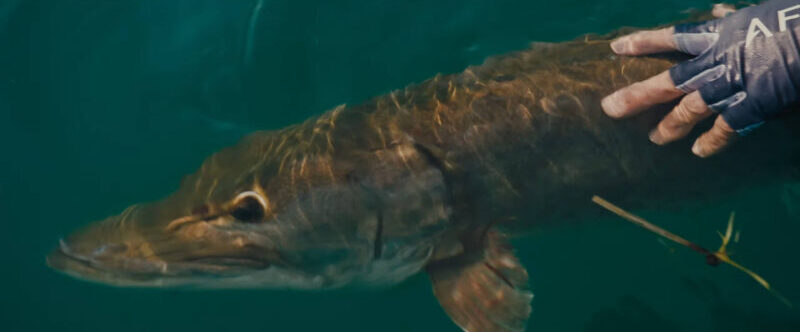If you’ve fought a muskie to the boat, you know this fish is no small catch. For most anglers, it isn’t just another meal. It’s a prize fish to release back into the water, keeping the thrill alive for the next time.
But let’s get real. Some people eat it. They describe it like pike with a firm, mild taste, although dealing with the bones takes a little patience.
Now, I don’t typically go for muskie myself. Still, if you’re interested in eating it, there’s more to consider beyond taste. Health warnings advise against regular consumption because of mercury levels, and opinions are split among anglers who either swear by it as a trophy or find it’s fine for the table.
If you’re thinking about this fish for your next meal, read on to get the full picture. It’s not impossible, but it’s worth knowing exactly what you’re getting into.
Key Takeaways
- Muskie has a mild, firm texture that some enjoy, but it’s tricky to prepare due to its bones.
- Health advisories suggest limiting muskie consumption due to mercury, especially for children and women.
- Most anglers practice catch and release to support muskie populations, though keeping one may be acceptable in invasive areas or for a rare trophy catch.
What Muskie Really Tastes Like (And Is It Worth It?)
Most people don’t think “dinner” when they hook it, but curiosity has led a few anglers to give it a try. The taste comparisons usually center around its close cousin, the pike.
You get a firm, mild flavor that doesn’t overpower, but the catch? It’s also dense and packed with bones, which many find to be a headache to prepare.
What People Say About Eating Muskie
- Firm and Mild – Some compare it to pike, calling it a mild, white fish with a firm texture. If prepared right, it can absorb flavors well in stews, croquettes, or even grilled.
- Bones Galore – Almost everyone who tried it warns about the Y-shaped bones running through the meat, which makes it a challenge to clean. For those willing to put in the effort, it’s best to learn the technique from someone with experience.
- “Gamey” but Not Overpowering – A few say it has a subtle “gamey” taste, but it’s often easy to mask with the right seasonings.
- “Not Worth the Trouble” – Some find the cleaning and deboning process frustrating, preferring to release muskie and focus on more common table fish like walleye or bass.
- “Better than Expected” – A handful of anglers swear it’s worth the work, comparing the taste to more expensive seafood like crab or lobster when paired with butter or lemon.
- “Stick to Pike” – Many feel that if you’re after something like it, you’re better off with pike. It’s easier to catch, often more plentiful, and has a similar taste profile without the hassle.
Off topic – If you are into Jug fishing, check out this guide.
How to Prepare It?
If you’re set on trying muskie, prep work is key. This fish isn’t your typical easy fillet job; it’s got a bony structure that needs patience and technique to get right. I’ve heard from plenty of anglers who have tried (and sometimes failed) to prep it, and a few have some solid tips for making the process smoother.
Cleaning Without Losing Your Mind

Preparing takes more than just a quick slice and fillet. Here’s what experienced people recommend:
- Learn the Y-Bone Technique – Muskie and pike both have Y-shaped bones, and learning to remove them is the first step. Start by watching someone skilled in pike prep or checking out online tutorials that walk you through it.
- Use Sharp Tools – Many swear by having a razor-sharp fillet knife and a pair of needle-nose pliers on hand. The pliers help grip and remove smaller bones without damaging the flesh.
- Consider Steaking It – If deboning sounds too tedious, some anglers skip filleting altogether and slice it into thick “steaks.” This approach leaves bones intact but works well for grilling or smoking.
Advice from the Pros
- Rinse and Soak – Before cooking, soaking fillets in milk or lightly salted water helps remove any lingering “gamey” flavor.
- Go for Stews or Croquettes – Because it has firm flesh, it holds up well in recipes where you can balance the flavor. Many say muskie is best when blended with seasonings in croquettes or simmered in a savory stew.
- Avoid Overcooking – It tends to dry out quickly, so cook it at a moderate temperature, just until firm and flaky.
Guide to Cleaning Muskie
If you’re ready to give muskie a try, it’s important to know how to tackle the toughest part: cleaning it right. This isn’t your average fillet job. Muskie has thick skin and Y-shaped bones that make it a bit of a project, but with the right technique, you can handle it like a pro.
Steps for Cleaning and Filleting
- Sharp Knife is Key – Start with a knife that’s sharp enough to get through muskie’s tough skin and dense bones. This will save you a lot of effort and frustration.
- Skin It First – Grip the fish firmly and remove the skin first. Without the slippery exterior, the filleting process becomes easier.
- Find and Remove the Y-Bones – Muskie has a unique bone structure that takes a bit of patience. Carefully cut along the top and bottom of the Y-bones to keep the meat intact.
- Divide into Sections – Muskie are large fish, so working in sections makes it easier to control and remove any hidden bones.
Tips from Those Who’ve Done it Before
- Consider Steaks Over Fillets – Some people prefer cutting muskie into “steaks,” especially if they plan to grill or smoke it. It leaves the bones in but saves time on deboning.
- Have Pliers Handy – A pair of needle-nose pliers makes it easy to pull out any smaller bones that might get missed.
Tried-and-True Muskie Recipes for the Curious

If you’re ready to take muskie from lake to plate, knowing how to cook it well makes all the difference. Muskie has a firm texture and mild flavor that works best in dishes where it can soak up seasonings and hold up under heat.
Here are a few recipes that seasoned anglers recommend for getting the best out of this unique catch.
Muskie Croquettes Recipe |
|
|---|---|
| Ingredients |
|
| Instructions | Mix the muskie, potatoes, and onions until well-combined.
Form small patties, coat in breadcrumbs, and fry in a pan with oil until golden brown. |
Muskie Cakes Recipe |
|
|---|---|
| Ingredients |
|
| Instructions | Mix the muskie with the other ingredients until well-blended.
Form into small patties, pan-fry in oil until golden on both sides and serve with lemon wedges. |
Grilled Muskie Steaks with Herb Butter Recipe |
|
|---|---|
| Ingredients |
|
| Instructions | Brush the steaks with olive oil, season with salt and pepper, and grill over medium heat.
Add a dollop of herb butter just before serving. |
Mercury and Health Risks
If you plan to try it, think of muskie as a rare treat instead of something regular.
- Mercury Concerns – Since muskies eat other fish, they end up storing mercury in their bodies over time. This makes them one of the species that health experts advise against consuming too frequently.
An advisory note from the Wisconsin Department of Natural Resources (WDNR) states, “While they are rarely targeted for human consumption, these long-lived, slow-growing, top-of-the-line predators can accumulate contaminants such as mercury or PCBs (polychlorinated biphenyls). WDNR recommends that women of childbearing age and children under 15 do not eat muskies. Men (and older women) should only eat 1 meal per month, and no more than 6 meals per year from Green Bay.”
Tips from Anglers Who’ve Tried It
People who do eat muskie from time to time share a few tips to keep it as safe as possible:
- One Meal a Year – Some anglers limit themselves to just one muskie meal a year, especially if caught in waters with higher mercury levels.
- Stick to Smaller Fish – Larger, older muskie tend to contain higher toxin levels. Choosing smaller muskie, if it’s allowed, can mean lower risks.
Catch and Release is the Most Popular Option

Most anglers release muskie to keep populations strong and to allow others the chance to experience the thrill of reeling one in.
Muskies take years to mature and can be vulnerable to overfishing. Releasing them helps ensure the population stays stable, especially in heavily fished areas.
Muskie are known as a “fish of a thousand casts,” meaning each catch is a true prize, worth preserving for future generations.
Also, if you prefer fishing over winter, I got some tips for you for catching a White Bass.
When It’s Okay to Keep Your Catch?
In some non-native areas, muskies are considered invasive and are less restricted by catch-and-release guidelines(For example, in Lake Frontiers). In these places, keeping muskie can help control their impact on native species.
Final Words
Muskie is a unique fish, both as a catch and as a meal. For most anglers, the thrill of reeling in such a powerful fish makes it worth releasing, keeping muskie in the water for the next person to experience.
But if you’re curious about trying it on your plate, there’s no harm in doing so now and then, especially with a thoughtful approach to cleaning, cooking, and respecting health guidelines.

